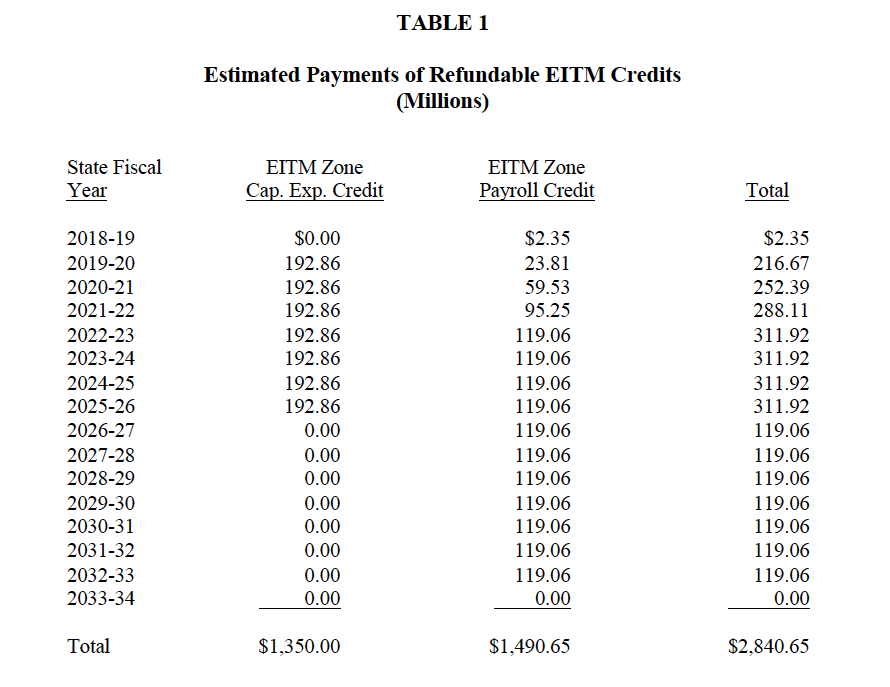Report: State Breaks Even on Foxconn Deal in 2042
- Share
- Tweet
- Pin
- Share
In a report acknowledged to be based on “estimates and assumptions,” the nonpartisan Legislative Fiscal Bureau found that it could take almost three decades for the state to break even on the $3 billion incentive package it is using to lure Foxconn to build a $10 billion plant in southeastern Wisconsin.
The report compares the amount of tax breaks being offered to the Taiwanese manufacturing company to the estimated tax revenue Foxconn would generate, and cites Department of Administration figures that the state would reach the break-even point in fiscal year 2042-43.
However, the report adds that if just 10 percent of the new jobs at the plant are filled by Illinois residents, that would push the break-even point back to 2044-45.
The report also cites a separate analysis by the accounting firm Baker Tilly Virchow Krause, LLP, which has been retained by the Wisconsin Economic Development Corp. to assist with Foxconn negotiations, where they indicated 40 to 50 percent of the construction and ongoing jobs could potentially be filled by nonresidents, which the report says would delay the break-even point well beyond 2045.

The report does go on to say the Walker administration believes Baker Tilly “significantly overstates the number of nonresidents who would be working at the facility,” and that the firm is “currently revising its analysis to incorporate feedback by the administration and EY [the consulting firm formerly known as Ernst & Young prepared its own economic impact analysis].”
The report also addresses the various job numbers that have been tossed out – from a low of 3,000 to a high of 13,000. If the numbers are at the lower end, that too will place the break-even point beyond 2045.
Ultimately, the report said the state would spend $100 million annually on this deal from 2019 through 2027-28.
However, the report also notes there are other fiscal factors at play beyond the deal’s impact on the state treasury.
“For example, based on the assumptions outlined above, the capital expenditure credit and sales tax exemption would have a value of approximately $1.5 billion, but would induce private investment of $10 billion from Foxconn alone, for a leverage ratio of $6.70 of private investment for each $1 of public outlay. …Most state expenditures do not result in private investments of this nature. The project would also provide greater employment opportunities for the state’s present and future workforce, and add a new sector to the state’s manufacturing economy.”
Here are a few other details from the report:
- Creation of a new position called Economic Development Liaison to serve as state’s primary point of contact for any matters regarding Foxconn. That job is budgeted at $183,500 in 2017-18 and $177,500 in 2018-19.
- Create a granting program to local governments for costs associated with development occurring in the electronics and information technology manufacturing zone. Ten million dollars would be budgeted for 2017-18.
- Authorize $252.4 million in general obligation bonds for the I-94 North-South corridor, with the stipulation that the Department of Transportation cannot expend the funds unless the state receives federal money for the project.
- A sales and use tax exemption “for tangible personal property and landscaping and lawn maintenance services” for facilities located in an Electronics and Information Technology Manufacturing (EITM) zone. The Dept. of Revenue estimates a $139 million tax savings for Foxconn and its contractors during the 15-year life of the EITM zone. The report adds: “However, since it is highly unlikely that Foxconn would locate in the state without the incentives provided under the bill, this amount should not be viewed as a state revenue loss.”
- Estimates assume 10,200 construction workers and equipment suppliers will be needed throughout the planned four-year construction period, with average total compensation at $59,000 annually, for a total income of $2.4 billion. Add to that another 6,000 indirect jobs created during the construction period, with an average total compensation of $48,900, and it was determined the total increased state taxes associated with the construction period are estimated at $186.9 million.
